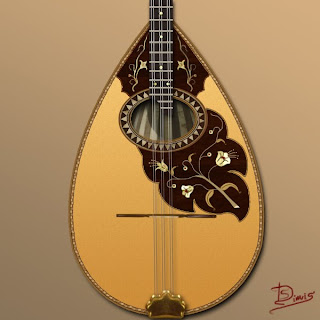Aesthetic basics
And the subjectivity of aesthetics.
Accordingly to the famous luthier, Niko Fronimopoulo, in an interview he gave on January 2009, when he was asked:
-What should be the characteristics and qualifications of a luthier, today?
he answered:
"The lutherie, borrows many elements from many other arts (carpentry, woodcarving, decoration, design, etc.). Also, uses the results of science, such as acoustics, chemistry and engineering. Thus, the instrument maker is a craftsman, who should know all of these elements, which will push him to evolve even further, the art of lutherie. And certainly he should have a very good knowledge of music, so he is able to evaluate the quality of sound, produced by his instruments, but also he should have a broader general education, in order to monitor new developments in his field, and be able to access multiple information that are available today."
(http://www.klika.gr/ )
Taking the opportunity from last week's conversation,which I had with a few friends from NY, regarding the subjective evaluation of aesthetics, finish, and quality of materials that have been used on a bouzouki instrument, I thought to create with my digital tools, a quick comparison between two bouzouki designs (inspired by real instruments), and evaluate together, their aesthetics, finish, and materials that are used, just for the decoration of their soundboard, sound hole and the fillets around the bowl.
1. At the first trixordo, the soundboard's floral decoration has been created by, natural woods and golden MOP(for the flowers). The decoration around the sound hole and trims are made by wooden marquetry. Round fret marks, have been made by wood. Pick guard created by natural rosewood.
2. At the second trixordo, the soundboard's floral decoration, has been created by natural woods. The decoration around the sound hole created by imitation of abalone, with engraved decorative floral elements of real abalone. Oval fret marks, have been made by abalone. Trims around the bowl created by plastic trim, blue and green acrylic celluloid, rosewood, and real abalone. Pick guard created by natural rosewood.
Lets assume that, both instruments are approx. at the same price range, and they produce the same quality of sound.


Before writing my analysis, I am inviting the friends of this blog to participate on the poll, write at the comment section their personal evaluation of the two instruments, and their opinion,on which one,(and if possible why), is the most aesthetically attractive to their personal taste.
Accordingly to the famous luthier, Niko Fronimopoulo, in an interview he gave on January 2009, when he was asked:
-What should be the characteristics and qualifications of a luthier, today?
he answered:
"The lutherie, borrows many elements from many other arts (carpentry, woodcarving, decoration, design, etc.). Also, uses the results of science, such as acoustics, chemistry and engineering. Thus, the instrument maker is a craftsman, who should know all of these elements, which will push him to evolve even further, the art of lutherie. And certainly he should have a very good knowledge of music, so he is able to evaluate the quality of sound, produced by his instruments, but also he should have a broader general education, in order to monitor new developments in his field, and be able to access multiple information that are available today."
(http://www.klika.gr/ )
Taking the opportunity from last week's conversation,which I had with a few friends from NY, regarding the subjective evaluation of aesthetics, finish, and quality of materials that have been used on a bouzouki instrument, I thought to create with my digital tools, a quick comparison between two bouzouki designs (inspired by real instruments), and evaluate together, their aesthetics, finish, and materials that are used, just for the decoration of their soundboard, sound hole and the fillets around the bowl.
1. At the first trixordo, the soundboard's floral decoration has been created by, natural woods and golden MOP(for the flowers). The decoration around the sound hole and trims are made by wooden marquetry. Round fret marks, have been made by wood. Pick guard created by natural rosewood.
2. At the second trixordo, the soundboard's floral decoration, has been created by natural woods. The decoration around the sound hole created by imitation of abalone, with engraved decorative floral elements of real abalone. Oval fret marks, have been made by abalone. Trims around the bowl created by plastic trim, blue and green acrylic celluloid, rosewood, and real abalone. Pick guard created by natural rosewood.
Lets assume that, both instruments are approx. at the same price range, and they produce the same quality of sound.


Before writing my analysis, I am inviting the friends of this blog to participate on the poll, write at the comment section their personal evaluation of the two instruments, and their opinion,on which one,(and if possible why), is the most aesthetically attractive to their personal taste.

Φίλε μου memorise και τα δύο τρίχορδα είναι πολύ όμορφα,προσωπικά κλείνω προς το δεύτερο, γιατί μου αρέσει πολύ ο συνδυασμός του ξύλινου καπλαμά στην φιγούρα ,με το αληθινό abalone στα δεσίματα του οργάνου.Στο σημείο αυτό θέλω να σου δώσω πολλά συγχαρητήρια για τα εξαιρετικά σχέδια που φτιάχνεις με τον υπολογιστή σου,έβλεπα και κάποιους τζουράδες σε προηγούμενες αναρτήσεις σου και μπορώ να σου πω με βεβαιότητα πως έχεις μεγάλο ταλέντο σε αυτό!!! Καλή Ανάσταση και καλό Πάσχα,να περνάς όμορφα!!!
ReplyDeleteΚαι το πρώτο βέβαια είναι πολύ όμορφο!!!
ReplyDeleteΑγαπητε φίλε luthierschool,
ReplyDeleteσε ευχαριστώ πολύ για τη συμμετοχή σου στην ψηφοφορια. Επισεις σε ευχαριστω για την αναγραφη της αιτιολογίας στο γιατί το δεύτερο μπουζουκι είναι για σένα, αισθητικα πιο όμορφο.
θα συμφωνησω μαζι σου εν μερη, δηλαδη στο οτι η αρχικη σκεψη του υποτιθεμενου οργανοποιου, να χρησιμοποιησει abalone(κρυο χρωμα)σε συνδοιασμο με το "ζεστο χρώμα" του καπλαμά και των ξυλινων διακοσμητικων, ειναι μια πολυ καλαισθητη απόφαση..αρκει βεβαια να υλοποιηθει με το σωστό τροπο.
Να σε ευχαρτιστησω επισεις για τα καλα σου λογια.Περιμενω σχολια σου οταν θα αναρτησω την αποψη μου περι της αισθητικης των δυο concept τριχορδων
ReplyDelete